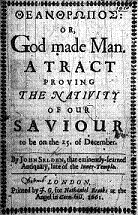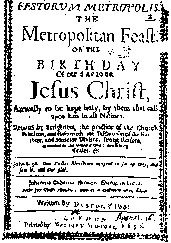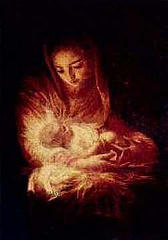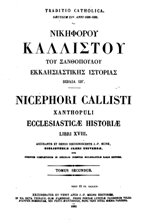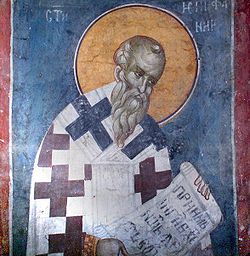The Jewish Calendar
Adapted from an article by Holger Oertel
http://www.ortelius.de/kalender/j_uk.php
[Editor's note: In order to reconstruct the priestly courses and determine when John the Baptist was conceived and Chirst was born, some basic facts about the Jewish calendar are necessary. The present article provides some of that information.]
The history of the Jewish calendar traces back until the second millenium BCE. At these times, a luni-solar calendar seems to have been in use already, in which the decision of intercalating a month was made according to observations. Only four months had names (Abib, Ziv, Bul, Ethanim), the other months having been designated with their numbers. In 587 BCE, Jerusalem was destroyed by the Babylonian king Nebukadnezar II. and many Jews deported to Mesopotamia, where, influenced by the Babylonian month names, the Jewish months got their names. After the Persian king Kyros had defeated the Babylonian Empire, the Jews were allowed to return to Jerusalem, were a small state was created, which consisted of the city itself an some area around it. This state was part of Persia and later of the Seleucid(Empire and Egypt. This is the period known as the time of the Second Temple (538 BCE until 70 CE).
Not only intercalation, but also the beginning of each month was determined by observation. A calendar council gathered on the 30th day of each month and consulted witnesses, which had to report on the visibility of the moon's crescent. Had the crescent been visible, the actual day was declared to be the first day of the new month. Otherwise, the new month began only with the following day. The decision was published and sent to all communities by fire signals. But, according to reports from the second century CE, Samaritans gave false signals, causing many Jews to fall into error. The message was therefore carried to the communities by messengers, but with many Jewish communities too far away to be reached in time, the actual date became uncertain. Therefore, the Jews celebrated all feasts on two consecutive days, making sure, that any feast was observed. Only Yom Kipur was observed only on one day.
The Jewish state gained independence again in 140 BCE, and by the end of the century a Jewish kingdom had evolved. Soon the throne was disputed giving the Romans possibilities to get involved. In 63 BCE, Palestine was occupied by Roman troups led by Pompeius. The Jewish state remained formally independent, but in fact had to obey Roman orders. In this time, the Sanhedrin was created, which became the highest authority on problems whithin the Jewish state, including the determination of the calendar, which was observation-based, yet.
Following quarrels between Greek and Jewish inhabitants of Palestine, a full-scale Jewish uprising developed in 66 CE. The Romans sent Vespasian to suppress the rebellion. After Nero's death a civil war broke out in the Roman Empire itself, which Vespasian could win, becoming emperor in 69 CE. Vespasian's son, Titus, took over the lead of the Roman troups in Palestine. Eventually, Jerusalem and the Temple were destroyed in 70 CE.
The Sanhedrin was re-created by the end of the first century CE and was now led by a patriarch. With the Jews now having communities almost all over the world then known, a regular scheme for the calendar became necessary. With such rules, anyone could determine the date regardless how far he lived from Jerusalem.
After the uprising led by Bar-Kokhba (132 CE) persecutions against the Jews reached an intensity which made it almost impossible to communicate the beginnings of months and years. Now, computational rules were being established concerning the calendar, and in the beginning fourth century CE the beginnings of the months were determined by calculation, the report of witnesses having become a mere formality. There was some opposition against this practice within the Sanhedrin, and Jews in Babylon and Alexandria were told to continue to celebrate the feasts on two days, which is done by the Jews in the diaspora until today.
When Constantine became Roman emperor, the Christian religion de facto became the official religion in the empire. It was forbidden to exercise the Jewish religion at all, including to do calculations in connection to the Jewish calendar. This led, in 359 CE, to patriarch Hillel II. publishing rules for computing the calendar which had been regarded as a secret until then (3). The 19-year leap year cycle was fixed to the present order, while the era and some rules for determining New Year were set only until the 10th century. The era used until the 11th century was the era of the Seleucids, starting in 312 BCE, while from the 10th until the 16th century, the Jewish Creation era came into use, which starts in 3761 BCE. Units for Counting Time
A day is divided into 24 hours (1 hour: sha'a) consisting of 1080 parts (khalakim) each. The hours are counted from the beginning of the day which is 6 p.m. for civil use. Writing 1 H for a Jewish hour an 1 P for a part gives
1 H = 1 h = 1080 P and
18:00 h = 0H Jewish time.
1 Tishri 5758 is thus beginning on 1 October 1997, 6 p.m. and ends 2 October 1997, 6 p.m. Finally, a part is divided into 76 moments (rega'im).
For religious purposes the period of daylight is divided into 12 hours as is the dark night making the length of this hours vary as the seasons change. Thus, the Jewish holidays begin with sunset. Calculation of the Beginning of the Year and Jewish
The beginning of the year is determined by cyclic calculation based on the lunar month as well as the tropical year. The conjunction of sun and moon (or new moon; in Hebrew: Molad) fixes the beginning of the month. The Molad of the month Tishri (Molad Tishri) together with some additional regulations determines New Year's Day (Rosh Ha-Shanah).
The mean lunar month is taken as 29 d 12 H 793 P (29 d 12 h 44 min 31/3 s). The epoch of the calculation of the moladot is Sunday, 6 October 3761 BCE, 23:11:20h, expressed in the Julian calendar. As explained above, in the Jewish calendar this is already Monday, 5 H 204 P which is from when the Jewish days, months, and years are counted. The following moladot can easily be calculated by repeatingly adding the mean length of a Molad (29 d 12 H 793 P).
The astronomical new moon can occur as much as 14 hours before or after the cyclic calculation but this has no practical meaning. The beginning of the month can be shifted one or two days by the regulations explained later.
Twelve such months make 354.3713 days which is about 11 days short of the tropical year. To keep the calendar aligned with the seasons, a cycle of 19 years consists 12 common years and 7 leap years (shanah me'uberet), the latter being lengthened by an additional month. It is not possible to add single days for the months must be kept aligned with the moon's phases. A year is a leap year when the number leaves a remainder of 0, 3, 6, 8, 11, 14, or 17 when divided by 19.
The complicated fixing of Rosh Ha-Shanah results in the common year having a length of 353, 354, or 355 days. The year is called defective (shanah khasera), regular (shanah kesidra), and perfect year (shanah shelema), respectively. Because of the addition of another 30-day month, a leap year can have 383, 384, or 385 days.
A common year consists of 12 months, while a leap year has 13 months. The length of each month is 29 or 30 days. The following table shows the names and lengths of the months for the different years, the total lengths of which is to be found in the last line.
|
||||||||||||||||||||||||||||||||||||||||||||||||||||||||||||||||||||||||||||||||||||||||||||||||||||||||||||||||||||||||||||||||||||||||||||||||||||||||||||||||||||
The religious year begins with Nisan as the first month and ends with Adar which is the twelfth month in common years and the thirteenth month in leap years. Thus, Nisan is considered to be the first month, while Adar is the twelfth, Adar sheni in leap years the thirteenth month. Adar is counted as the last month anyway. Adar rishon and Adar sheni are sometimes called Adar I and Adar II, respectively. For Adar sheni one can find the name We-Adar occasionally.
The main festivals are:
- Rosh Ha-Shanah (New Year's Day): 1 and 2 Tishri,
- Yom Kippur (Day of Atonement): 10 Tishri,
- Sukkot: 15 Tishri,
- Simkhat Torah: 22 Tishri (outside Israel 23 Tishri),
- Passah, first day: 15 Nisan,
- Passah, last day: 21 Nisan (outside Israel 22 Nisan),
- Yom ha-Azma'ut (Independence Day): 5 Iyyar, and
- Shavuot: 6 Sivan.
There are minor festivals:
- 10 Tevet,
- Tu bi-Shevat: 15 Shevat,
- Ta'anith-Esther: 13 Adar (shifted to the preceeding Thursday if it falls on Saturday),
- Yom ha-Sho'ah (Holocaust Memorial Day): 27 Nisan,
- Lag ba-Omer: 18 Iyyar,
- 17 Tammus and 9 Av (postponed to Sunday if they are on Saturday), and
- 15 Av.
Further feasts are
- Khanukkah: 8 days, beginning with 25 Kislev and
- Purim: 14 Adar (Adar sheni in leap years).
Remarks
1 Three of the months are mentioned in the Old Testament explicitly: Ziv as 2nd month (1 Kgs. 6,1), Bul as 8th month (1 Kgs. 6,38), and Ethanim as 7th month (1 Kgs. 8,2).
2 Palestine became part of the Empire of Alexander the Great in 332 BCE. But, soon after Alexander's death, his empire disintegrated. Of the new states, the Seleucid empire became a considerable power, while under the Ptolemaios dynasty Egypt remained an independent state until it was annexed to the Roman Empire. The small Jewish state was disputed between Egypt and the Seleucid empire during the 4th and 3rd century BCE. In 198 BCE, it eventually fell to the Seleucids.
3 Another version says that the calendar was published as late as 500 CE, but that seems to rest on a mistake.
___________________________________
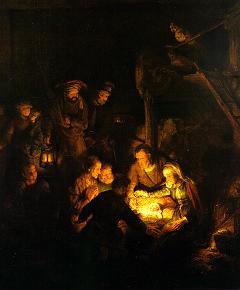
Adoration of the Shepherds
All rights reserved.
 John Seleden’s
John Seleden’s